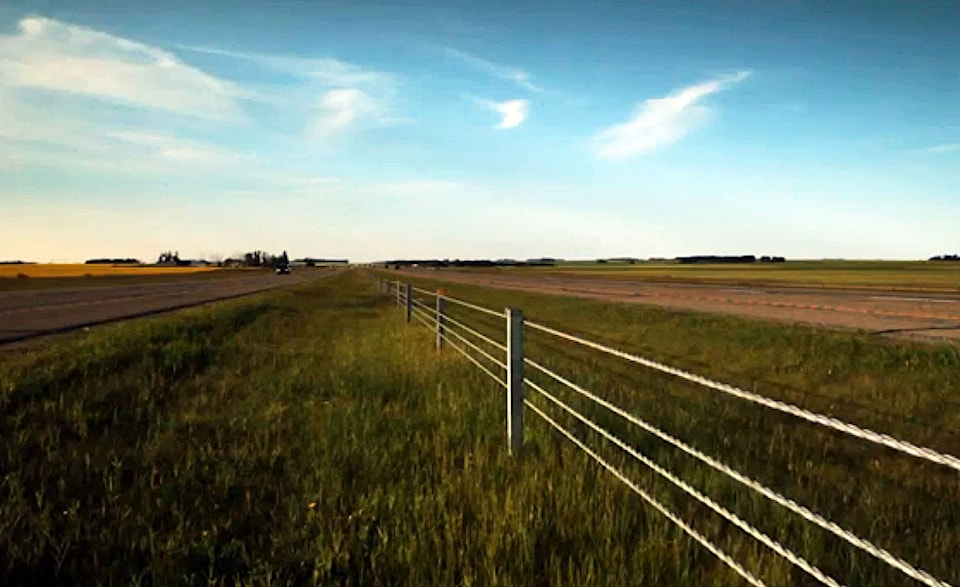Alberta Transportation is defending the Hwy 2 cable barrier system after concerns were raised following the death of a motorcyclist.
The 133-km cable barrier was installed along Hwy 2 between Red Deer and Airdrie in June 2010 as part of the province’s $8.2 million barrier project.
The 21-year-old Red Deer man died after his motorcycle hit the centre median cable barrier system on Hwy 2, south of the Hwy 11 overpass on Wednesday afternoon.
The cause of the collision, or the man’s identity, have not been released. Police said speed or alcohol were not factors.
Alberta Transportation is sticking behind statistics, saying the barrier is making Alberta highways safer.
“This is a very, very unfortunate incident,” Alberta Transportation spokesperson Nancy Beasley Hosker said Friday. “We will be looking at the police report to clarify the cause.”
Beasley Hosker said before the installation along the corridor there was an average of 106 collisions every year involving vehicles losing control and travelling through the median. There were 15 fatals in the five years before the installation.
“That’s what we are trying to prevent,” she said. “We are trying to save lives. We all want to save lives and minimize injuries.”
Beasley Hosker said there have been no fatal crossover collisions and a nearly 40-per-cent reduction in serious injury or fatal collisions since the system has been in place.
While the province has information on four-wheeled vehicles in relation to the cable barrier, currently it does not have any specific research on motorcyclists in relation to collisions with the barriers.
“We do have anecdotal stories that have indicated that motorists have seen motorcyclists strike the barrier, get back on their motorcycle and drive away,” said Beasley Hosker.
She said they have not been reported as injury free or fatal collisions because the motorcyclists have walked away. She said the barriers have significantly reduced the severity of injuries in collisions compared to steel or concrete.
The cable barrier was installed after extensive research on the type of barriers that are available, including the traditional concrete and steel and the cable barriers.
The barrier was first introduced on a 10-km stretch on the north end of Deerfoot Trail in Calgary in 2007. The cable barriers have been used in North America over the last 10 or 15 years.
Alberta was the first province in Canada to use the safety feature, which is regularly used in jurisdictions across the country. The province won a national safety award for the project. Beasley Hosker said the barriers have been one of the province’s most effective highway safety features.
The system acts similar to a spider web, catching a vehicle leaving the road in the barrier and preventing it from crossing the median and going into ongoing traffic, says a report from the Office of Traffic Safety.
“These barriers are flexible as opposed to a motorist hitting a cement wall,” she said. “There is no give there.”
Still a Red Deer County mother was brought to tears when she heard about Red Deer man’s death on Monday.
Barb Cross said when she heard the story she felt she had to come forward.
Cross and her husband wrote to Alberta Transportation about the concerns over the cables a few years ago after their daughter was in a collision on Hwy 2 near Gasoline Alley. Her then 19-year-old daughter was driving a car on Hwy 2 near Gasoline Alley when her car hit a patch of black ice and smashed into the cable, which propelled her car into traffic. Cross said her daughter was fortunate that there was no traffic because she may not have survived.
“When I saw this (Thursday), I was furious because this was not a necessary death,” said Cross. “It should have been dealt with beforehand. These cables are dangerous to cars. They are dangerous to motorcyclists. They are dangerous to people. They are dangerous to people who are in cars.”
Cross said this should not have happened.
“I thought, you know, a lot of us who have had these experiences need to combine together,” said Cross. “We need to support this young man’s family. I am devastated that this happened to someone else. This didn’t need to happen.”
crhyno@www.reddeeradvocate.com
